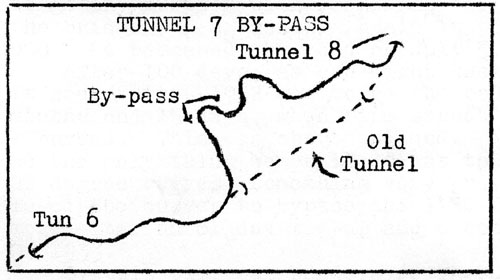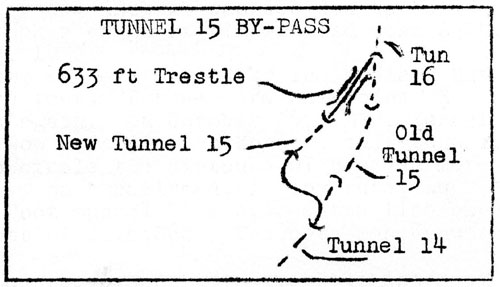R-29-5
I thought it should we barricaded the opposite end of the tunnel. This was to no avail, as we had a cave in 400 feet from the west end of the tunnel. With this draft caused by the heat in the tunnel, we had to take out the barricades and let it burn. This tunnel burned for 4 days. We were tied up for 45 days and ended up with two tunnels, one 318.83 feet and one 897.25 feet. After using a solid cargo of timber to repair this tunnel, we reopened March 10, 1932 at a cost of $158,863.
Now our troubles were to continue as we had Tunnel 15 which we had been watching for over a year. This tunnel was beginning to slide. We were working on a 50 foot concrete approach, thinking this would save the tunnel. But 17 days after we opened tunnel 3, on the 27th of Maroh. Tunnel 15, 1146 feet, slid in.
This was going to be a job, as without the tunnel it was necessary to build a bridge 633 feet long and 185 feet high. This bridge was built on a l6 degree curve. You could understand there could not be much heart to go any further with reopening the road. But it was decided to build the bridge and a tunnel. Again it took a cargo of timbers and cost $319,000. We reopened the road on July 5, 1932.
After 100 days, as you might know, we were up and trying again. But it seemed that 1932 was to be the bad year. For we were only open 3 months and 15 days, when fire struck again. On October 20, 1932, Tunnel 7 burned. This was about the end. Now we could not bore another tunnel, so the only thing we could do was to circle the distance with seven more 20 degree curves, something very grave on a railroad. At any rate, we layed the curves to bypass the 1150 foot tunnel. We opened the line once more after an 81 day tie-up and a cost of $2l6,068. The date was January 9, 1933.
By this time our bonds were in bad shape. As the Spreckels interest did not care to continue, the S. P. took over the railroad entirely. We had a reorganization and in February, 1933 and renamed the railroad. It now became the San Diego & Arizona Eastern Railway.
From 1933 to 1940 our business was down, no doubt from our interruptions. We had lost many of our patrons. So the S. P. cut forces. I became chief in 1940.
With the War, came an increase in business. We had Camp Lockett at Campo, which necessitated several changes. Business was heavy on the North Island line also. But after the War our business dropped off to where we were again losing money. So in 1950, we decided to start proceedings to discontinue passenger service as it was losing $400,000 per year.
In January, 1951, we discontinued the passenger trains and also discontinued the use of steam engines. By doing away with steam power completely, we are able to economize and stay out of the red.
This is the story of the SD&AE. No doubt you will agree it was a struggle to exist.


| BACK | HOME | EXCURSIONS | GALLERY | FAQ | HISTORY | STORIES | SOUNDS | LINKS |